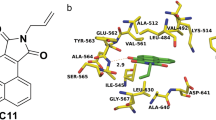Abstract
It has been shown that methionine depletion inhibits tumor cell growth and reduces tumor cell survival. A novel fusion protein targeted specifically to tumor cells was developed. The fusion protein contained two components: the amino terminal fragment of human urokinase (amino acids 1–49) that binds to the urokinase receptor protein expressed on the surface of invasive cancer cells, and the enzyme l-methioninase (containing 398 amino acids) which depletes methionine and arrests the growth of methionine-dependent tumors. The influence of the fusion protein on the growth and motility of human breast cancer cells was examined using a culture wounding assay. It was determined that MCF-7 breast cancer cells, used in this study, were methionine-dependent and that the fusion protein bound specifically to urokinase receptors of the surface of the cancer cells. Further treatment of the cancer cells with fusion protein over the concentration range 10−8 to 10−6 M produced a dose-dependent inhibition of both the migration and proliferation index of MCF-7 cells in the culture wounding assay over a period of 1 to 3 days. The results of this study suggest that this novel fusion protein may serve as a prototype for specific targeting of methioninase and perhaps other cytotoxic agents to cancer cells.






Similar content being viewed by others
Abbreviations
- ATF:
-
Amino-terminal fragment of urokinase (amino acids 1–49)
- PMSF:
-
Phenylmethylsulfonyl fluoride
- SDS-PAGE:
-
Sodium dodecyl sulfate-polyacrylamide gel electrophoresis
- TPCK:
-
N-p-Tosyl-l-phenylalanine chloromethyl ketone
References
Halpern BC, Clark BR, Hardy DN, Halpern RM, Smith RA (1974) The effect of replacement of methionine by homocystine on survival of malignant and normal adult mammalian cells in culture. Proc Natl Acad Sci U S A 71:1133
Mecham JC, Rowitch D, Wallace CD, Stern PH, Hoffman RM (1983) The metabolic defect of methionine dependence occurs frequently in human tumor cell lines. Biochem Biophys Res Commun 117:429
Kokkinakis DM, von Wronski MA, Vuong TH, Brent TP, Schold SC (1997) Regulation of O6-methylguanine-DNA methyltransferase by methionine in human tumour cells. Br J Cancer 75:779
Kokkinakis DM, Schold SC, Hori H, Nobori T (1997) Effect of long-term depletion of plasma methionine on the growth and survival of human brain tumor xenografts in athymic mice. Nutr Cancer 29:195
Tan Y, Zavala J, Xu M, Zavala J Jr, Hoffman RM (1996) Serum methionine depletion without side effects by methioninase in metastatic breast cancer patients. Anticancer Res 16:3937
Ellis V, Pyke C, Eriksen J, Solberg H, Dano K (1992) The urokinase receptor: involvement in cell surface proteolysis and cancer invasion. Ann N Y Acad Sci 667:13
Stoppelli MP, Corti A, Soffientini A, Cassani G, Blasi F, Assoian RK (1985) Differentiation-enhanced binding of the amino-terminal fragment of human urokinase plasminogen activator to a specific receptor on U937 monocytes. Proc Natl Acad Sci U S A 82:4939
Appella E, Robinson EA, Ullrich SJ, Stoppelli MP, Corti A, Cassani G, Blasi F (1987) The receptor-binding sequence of urokinase. J Biol Chem 262:4437
Hori H, Takabayashi K, Orvis L, Carson DA, Nobori T (1996) Gene cloning and characterization of Pseudomonas putida L-methionine-α-deamino-γ-mercaptomethane-lyase. Cancer Res 56:2116
Jacobs P, Cravador A, Loriau R, Brockly F, Colau B, Chuchana P, Van Elsen A, Herzog A, Bollen A (1985) Molecular cloning, sequencing, and expression in Escherichia coli of human preprourokinase cDNA. DNA 4:139
Argos P (1990) An investigation of oligopeptides linking domains in protein tertiary structures and possible candidates for general gene fusion. J Mol Biol 211:943
Esaki N, Soda K (1973) L-methionine γ-lyase from Pseudomonas putida and Aeromonas. Methods Enzymol 143:459
Laemmli UK (1970) Cleavage of structural proteins during assembly of the head of bacteriophage T4. Nature 227:680
Jain PT, Rajah TT, Pento JT (1997) Antitumor activity of a novel antiestrogen (Analog II) on human breast cancer cells. Anticancer Drugs 8:964
Nguyen TT, Zang XP, Pento JT (2002) Effects of KGF inhibitors on the migration and proliferation of breast cancer cells in a culture wounding model. Pharmacol Res 46:79
Stephens RW, Bokman AM, Myohanen HT, Reisberg T, Tapiovaara H, Pedersen N, Grondahl-Hansen J, Llinas M, Vaheri A (1992) Heparin binding to the urokinase kringle domain. Biochemistry 31:7572
Rabbani SA, Mazar AP, Bernier SM, Haq M, Bolivar I (1992) Structural requirements for the growth factor activity of the amino-terminal domain of urokinase. J Biol Chem 267:14141
Cavallaro U, del Vecchio A, Lappi DA, Soria MR (1993) A conjugate between human urokinase and saporin, a type-1 ribosome-inactivating protein, is selectively cytotoxic to urokinase receptor-expressing cells. J Biol Chem 268:23186
Vallera DA, Li C, Jin N, Panoskaltsis-Mortari A, Hall WA (2002) Targeting urokinase-type plasminogen activator receptor on human glioblastoma tumors with diphtheria toxin fusion protein DTAT. J Natl Cancer Inst 17:597
Abuchowski A, van Es T, Palczuk NC, Davis FF (1977) Alteration of immunological properties of bovine serum albumin by covalent attachment of polyethylene glycol. J Biol Chem 252:3578
Tan Y, Sun X, Xu M, An Z, Tan X, Han Q, Miljkovic DA, Yang M, Hoffman RM (1998) Polyethylene glycol conjugation of recombinant methioninase for cancer therapy. Protein Expr Purif 12:45
Acknowledgements
The authors acknowledge the support of the University of Oklahoma, Bioengineering Center. This work was also supported in part by grants from NIH/NCI (CA-89740), DoD (DAMD17-01-1-0591) and OCAST (HR03-046).
Author information
Authors and Affiliations
Corresponding author
Additional information
K.P. and S.A.G. are intern students from Blaise Pascal University, Clermont-Ferrand, France. M.B. and D.P. are intern students from the University of Limoges, France.
Rights and permissions
About this article
Cite this article
Peron, K., Jones, T.N., Gauthier, S.A. et al. Targeting of a novel fusion protein containing methioninase to the urokinase receptor to inhibit breast cancer cell migration and proliferation. Cancer Chemother Pharmacol 52, 270–276 (2003). https://doi.org/10.1007/s00280-003-0666-0
Received:
Accepted:
Published:
Issue Date:
DOI: https://doi.org/10.1007/s00280-003-0666-0




